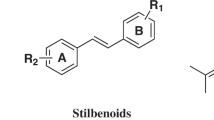Abstract
A series of novel substituted 4-thiazolidione derivatives were designed, synthesized, and evaluated in vitro for their antibacterial activities, in comparison with methicillin and ampicillin. Compounds (7d, 7h–k) exhibit good potency in inhibiting the growth of Staphylococcus epidermidis (MIC: 1.57–3.13 μM). Further antibacterial effects of compounds (7d, 7h–k) were investigated using clinical isolates (methicillin-resistant Staphylococcus epidermidis and methicillin-resistant Staphylococcus aureus), in comparison with methicillin and levofloxacin. Compound 7k showed the most potent antibacterial activities among the synthesized compounds.


Similar content being viewed by others
References
Davies DG, Parsek MR, Pearson JP, Iglewski BH, Costerton J, Greenberg E (1998) The involvement of cell-to-cell signals in the development of a bacterial biofilm. Science 280:295–298
Fabret C, Hoch JA (1998) A two-component signal transduction system essential for growth of Bacillus subtilis: implications for anti-infective therapy. J Bacteriol 180:6375–6383
Garrett DO, Jochimsen E, Murfitt K, Hill B, McAllister S, Nelson P, Spera RV, Sall RK, Tenover FC, Johnston J (1999) The emergence of decreased susceptibility to vancomycin in Staphylococcus epidermidis. Infect Control Hosp Epidemiol 20:167–170
Götz F (2002) Staphylococcus and biofilms. Mol Microbio 43:1367–1378
Hoffman LR, D’Argenio DA, MacCoss MJ, Zhang Z, Jones RA, Miller SI (2005) Aminoglycoside antibiotics induce bacterial biofilm formation. Nature 436:1171–1175
Huebner J, Goldmann D (1999) Coagulase-negative Staphylococci: role as pathogens. Annu Rev Med 50:223–236
Luo Y, Ma L, Zheng H, Chen L, Li R, He C, Yang S, Ye X, Chen Z, Li Z (2009) Discovery of (Z)-5-(4-methoxybenzylidene) thiazolidine-2, 4-dione, a readily available and orally active glitazone for the treatment of concanavalin A-induced acute liver injury of BALB/c mice. J Med Chem 53:273–281
O’Gara JP, Humphreys H (2001) Staphylococcus epidermidis biofilms: importance and implications. J Med Microbiol 50:582–587
Pan B, Huang RZ, Han SQ, Qu D, Zhu ML, Wei P, Ying HJ (2010) Design, synthesis, and antibiofilm activity of 2-arylimino-3-aryl-thiazolidine-4-ones. Bioorg Med Chem Lett 20:2461–2464
Pan B, Huang R, Zheng L, Chen C, Han S, Qu D, Zhu M, Wei P (2011) Thiazolidione derivatives as novel antibiofilm agents: design, synthesis, biological evaluation, and structure-activity relationships. Eur J Med Chem 46:819–824
Qin Z, Zhang J, Xu B, Chen L, Wu Y, Yang X, Shen X, Molin S, Danchin A, Jiang H (2006) Structure-based discovery of inhibitors of the YycG histidine kinase: new chemical leads to combat Staphylococcus epidermidis infections. BMC Microbiol 6:96–113
Raad I, Alrahwan A, Rolston K (1998) Staphylococcus epidermidis: emerging resistance and need for alternative agents. Clin Infect Dis 26:1182–1187
Ramla M (2007) Synthesis and inhibitory activity of new benzimidazole derivatives against Burkitt’s lymphoma promotion. Bioorg Med Chem 15:6489–6496
Schreiber M, Res I, Matter A (2009) Protein kinases as antibacterial targets. Curr Opin Cell Biol 21:325–330
Sieradzki K, Roberts RB, Serur D, Hargrave J, Tomasz A (1999) Heterogeneously vancomycin-resistant Staphylococcus epidermidis strain causing recurrent peritonitis in a dialysis patient during vancomycin therapy. J Clin Microbiol 37:39–44
Stephenson K, Hoch JA (2002) Two-component and phosphorelay signal-transduction systems as therapeutic targets. Curr Opin Pharmacol 2:507–512
Vuong C, Voyich JM, Fischer ER, Braughton KR, Whitney AR, DeLeo FR, Otto M (2004) Polysaccharide intercellular adhesin (PIA) protects Staphylococcus epidermidis against major components of the human innate immune system. Cell Microbiol 6:269–275
West AH, Stock AM (2001) Histidine kinases and response regulator proteins in two-component signaling systems. Trends Biochem Sci 26:369–376
Acknowledgments
We would like to thank Professor Guoqiang Lin, Shanghai Institute of Organic Chemistry, Chinese Academy of Sciences, for his invaluable academic advice. This work was supported by the National Natural Science Foundation of China Grant no. 20942006 (S. Han), Grant no. 21072095 (S. Han), Grant no. 30800036 (D. Qu), Shanghai Municipal Committee of Science and Technology (08JC1401600), National High Technology Research and Development Program of China (863 Program 2011AA02A209) and Program for Changjiang Scholars and Innovative Research Team in University (Grant no. IRT1066).
Author information
Authors and Affiliations
Corresponding authors
Additional information
D. Zhao, H. Liu and L. Zheng contributed equally to this study.
Rights and permissions
About this article
Cite this article
Zhao, D., Liu, H., Zheng, L. et al. Synthesis of novel 4-thiazolidione derivatives as antibacterial agents against drug-resistant Staphylococcus epidermidis . Med Chem Res 22, 3743–3750 (2013). https://doi.org/10.1007/s00044-012-0363-9
Received:
Accepted:
Published:
Issue Date:
DOI: https://doi.org/10.1007/s00044-012-0363-9




